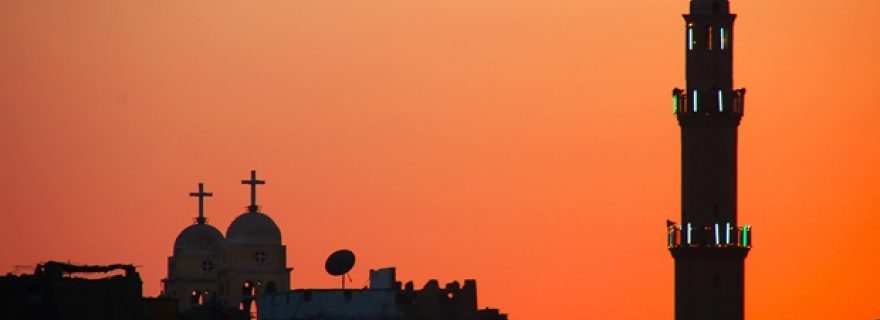Chrislam: Defying Nigeria’s Religious Boundaries
Nigeria, known for violent confrontations between Muslims and Christians, has also produced a movement that preaches the opposite: Chrislam.
Extremes in Nigeria
Nigeria is famous for its paradoxical extremes. It is a nation consistently ranked as one of the world’s most corrupt and yet also one of the most religious. Known for its corporate financial scams, deadly riots, and low human development index, Nigeria is at the same time recognised as possessing some of the happiest, most creative people on the planet and is Africa’s largest contributor to United Nations peacekeeping operations.
Within Nigeria’s religious milieu, similar extremes can be observed. While groups such as Boko Haram reify religious boundaries, lesser known, but important movements such as Chrislam are busy defying these same boundaries.
A New Religious Movement
If the term “Chrislam” sounds like something out of a science fiction novel, perhaps that is because linguistically that is where it originates. The first usage of the term can be traced to G.K. Chesterton’s 1914 dystopian novel, The Flying Inn, where remnants of Christianity are fused with a progressive form of Islam. Yet, beyond this fictional world, it is in Nigeria where “Chrislam” has been taken from merely a new word to a new religious movement.
As scholars Marloes Janson and Mustapha Bello have uncovered, Chrislam emerged in the megacity of Lagos in the early 1970s. While the content and form within each group of the movement varies, all attempt to fuse elements from Nigeria’s prominent religious traditions: namely, Islam, Christianity, and African Indigenous Religions.
This fusion is particularly apparent in one of the newest iterations of the movement, which is located in the southwestern city of Ogbómòsó. The group is called “The Ogbómòsó Society of Chrislam” (OSC) and was founded in 2005. What began as a small group of like-minded university students has swelled to over 200 active members in just over a decade.
While events at OSC are strikingly similar to other religious groups in the region, the key difference is what members call “a spirit of accommodation”. Beyond mere toleration or inclusion, however, OSC intentionally seeks to embed and synthesise Muslim, Christian, and indigenous African religious traditions. For instance, during the weekly service, the Quran, the Bible, and the Odù Ifá (the Yorùbá religious literary corpus) are simultaneously consulted.
During times of prayer, “The God of Africa, Jesus, and Muhammad” are called upon in unison, pointing to their belief that Christians, Muslims, and indigenous religious adherents follow the same God. As a frequent liturgical element from OSC states: “There is no God but God and only one religion. There are many prophets and divinities but only one God.”
Chrislam Rituals
Ritually, this fusion of traditions at OSC is fascinating and expresses a simultaneous attempt to defy and reinvent conventional religious boundaries, while also seeking to preserve and build consensus between traditions. Yemaya Wudu, for instance, is a ritual that utilises Islamic practices of washing in preparation for prayer and worship, but is fused with Christian baptism practices, as well as prayer to Yemaya, the Yorùbá goddess of the ocean.
Another ritual known as Chrislamic divination includes a typical Ifá divination, with palm nuts and an opele (divination chain), but the Babalawo (priest) regularly invokes the names of Muhammad and Jesus. Participants of this ritual contribute to this fusion by making the Christian sign of the cross and performing the Islamic salat. As one member, Shola, remarked about such practices:
“What outsiders may see as different or even contradictory traditions, we see continuity and uniformity … Sometimes this means creating new traditions, but even this newness is rooted in respect for very old traditions.”
Cognitive Dissonance?
OSC’s defiance of Nigeria’s religious boundaries begs many questions, not least of which is whether this is just a case of cognitive dissonance? Is it really possible to fuse multiple religious traditions? Aren’t they simply contradictory? Within my research at OSC, I found that members had an explanation for their beliefs. Instead of cognitive dissonance, I observed and listened to them attempting to reconstruct categories and resolve conflicting or contradictory theories to achieve some sort of consonance. While the combination of traditions may appear irrational, I found that their cosmological maps were able to synthesise and reinterpret religious traditions, even reinventing them, in an attempt to find what they viewed as the common essence.
Even if dissonance remains, a case like OSC challenges essentialised and normative typologies of religion. Indeed, while typologies can be helpful to a point, approaches that only allow for the possibility of classifying people in single, discrete categories are unhelpful and misleading. This thinking easily masks the varied, dynamic, and complex belongings and identities of people in the lived world, many of who live across and within multiple religious traditions.
At the very least, the Chrislam movement reminds us that while sustained interreligious encounters in Nigeria produce competition and tension, resulting in group reification, polarisation, and yes, even violent conflict, it can also provide a habitat of exchange and mutual influence—revealing the heterogeneous quality and mutability of communities and traditions – at times even resulting in innovative forms and movements that flex, cross, and defy categorical boundaries.



0 Comments